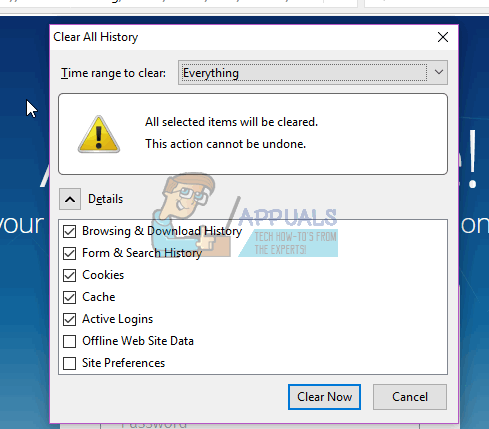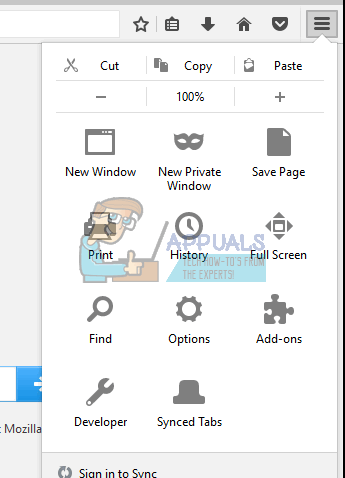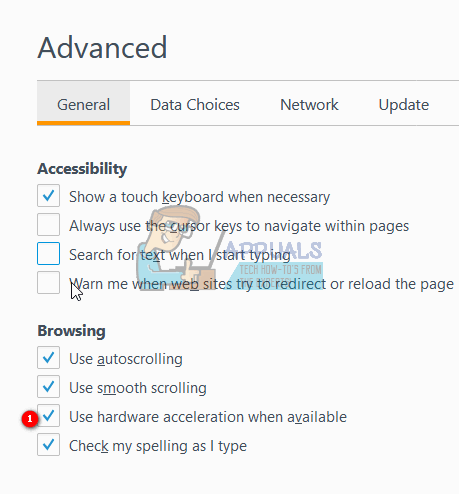Fix: Firefox Blank or White Screen
We all use Firefox browser for daily internet surfing. But sometimes you might face the issue of “Blank Pages” in Firefox. Basically whenever you open the browser you might see a completely blank page (white screen) with either no address in the address bar or a “about:blank” written in the address bar. Sometimes you might only be able to go around the blank page issue from the private browsing option. In other cases, the Blank Pages might show randomly on various websites like Facebook, blogs etc.
Just like there are many scenarios where you will be shown a blank page upon visiting a website, there are many reasons for this as well. Sometimes one of your extensions might be causing this issue. In some cases there might have been a corrupted History file that might be the reasons. In worst cases, all of this might be caused by a virus.
As there are many reasons for this to happen, we suggest you go through each method starting from method 1 and continue until your problem is solved.
Troubleshooting
The first thing to do is to clear the cache and cookies of the browser. Most of the time this solves your problem so try to clear the cache first and then start following the methods.
- Open Firefox
- Press CTRL, SHIFT and DELETE keys simultaneously (CTRL + SHIFT + DELETE)
- Check Forms and search history, Cache and Cookies
- Select the option Everything from the drop down list in the section Time range to clear
- Click Clear Now

Method 1: Disabling Extensions
Disabling your extensions will help you figure out the issue. If disabling all the extensions solves this problem then that means one of your extensions were causing this issue. To check which one was the reason behind it, try to enable the extensions one by one.
- Open Firefox
- Click the 3 lines on the top right corner
- Click Add-ons
- Click Extensions
- Click Disable for all the extensions that you can see there.
Check if the issue is resolved or not.

Method 2: Disable Hardware Acceleration
Disabling Hardware Acceleration also solves the problem of blank pages so try to follow the given steps to disable it.
- Open Firefox
- Click the 3 lines on the top right corner
- Click Options
- Click Advanced
- Click General tab
- Uncheck the option Use hardware acceleration when available

Method 3: Disable Shockwave Flash Player
If your page loads just for a moment and then goes blank and you can hear the sounds or music then shockwave flash player might be the issue. You can also trace the issue to shockwave flash player by checking if the pages that are going blank have a video embedded in them. Mostly the pages with an embedded video will go blank if shockwave is causing the issue.
Disabling Shockwave Flash Player will solve this issue in this case.
- Open Firefox
- Click the 3 lines on the top right corner
- Click Add-ons
- Click Plugins
- Select the option Never Activate from the drop down menu in front of the Shockwave Flash
If your plugin page isn’t even opening then try this.
- Open your browser
- Visit the website that gives the blank page. Once the blank page is shown
- Press CTRL, ALT and DELETE keys simultaneously
- Select Task Manager (if it asks) to open the Task Manager.
- Locate the Shockwave Flash Player
- Right click on flash player and select End task
Method 4: Administrator rights
Sometimes running Firefox as administrator works as well. This isn’t really a solution but a workaround this problem until the problem is solved. It is useful especially if you can’t access any page in the browser.
Method 5: Uninstall and Reinstall the browser
Uninstalling and reinstalling the software might solve the problem if the issue is because of the browser itself.
But before uninstalling, make sure the browser is closed.
- Press CTRL, ALT and DELETE keys simultaneously
- Select Task Manager (if it asks) to open the Task Manager.
- Now check to make sure your browser isn’t running. If you see your browser in the list then right click it and select End task.
Go here and download revouninstaller. It is a software that helps in removing a program completely from the PC. It removes the traces as well. In our case, we want the browser to be completely erased so that we can reinstall it. Download the software and install it. Now run the revouninstaller and select Firefox and uninstall it. Try to run the revouninstaller on Firefox multiple times to make sure you have uninstalled the browser completely.
Once done, reinstall the Firefox by re downloading the setup from the internet.
Method 6: Check Compatibility
Sometimes the Firefox application might be set to compatibility mode that maybe causing the issue. Removing the Run in Compatibility mode option solves this problem in that case.
- Right click the Firefox’s application
- Select Properties
- Click Compatibility tab
- Make sure the Run this program in compatibility mode for option is unchecked. It can be found under the Compatibility mode section
- Click Apply then Ok
Method 7: Deleting or Renaming Default Folder
- Hold Windows Key and press E
- Type
 in the address bar (the white box located on the top mid) and press Enter
in the address bar (the white box located on the top mid) and press Enter - Delete the Default folder (folder will be named as xxxxxxx.default where xxxxxxxx can be any random name). To do that, right click the Default folder and select Delete. If it asks for confirmation then select ok. Or right click the Default Folder and select Rename. Now type whatever you want and press Enter
Open Firefox and It should work fine now. You don’t have to worry about the default folder, Firefox will automatically create a new Default folder for you the first time you open Firefox again.
Method 8: Scan the Computer
If the problem is because of a virus then there are two things that you can do. The first thing is to download, if you don’t have already, an antivirus and scan the computer for any viruses. You can also use the Malwarebytes to check your computer for any infections.
If that doesn’t solve your problem then performing a System Restore might solve the problem especially if the problem just started to show in the browser. Go here and follow the step by step guide to perform a system restore of your computer.